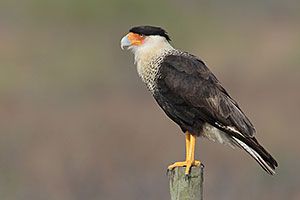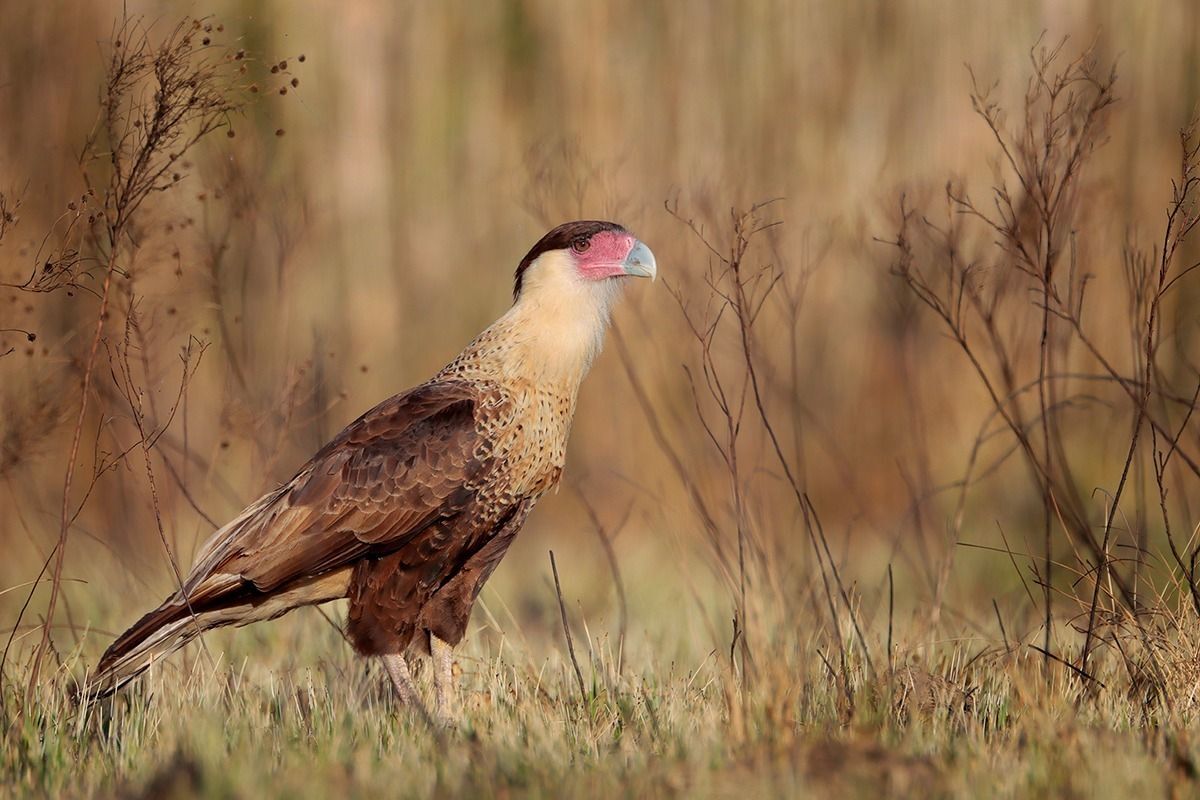Crested Caracara

© Greg Lavaty
Caracara cheriway
Preferred Habitat: Open habitats - fields and marshes.
Seasonal Occurrence: Throughout the year, but more common in winter. Breeds in our area.
Profile by Glenn Olsen: The Crested Caracara is the only member of the caracara group of birds to reach the United States. Their limited range is only in Texas, Arizona, and Florida. Caracaras are members of a neotropical group with several species ranging from Mexico, into Central America and on to South America.
Although members of the falcon family, caracaras are not typical in any observable respect of "true" falcons. And if field guides move to classification based on DNA, it is probable that caracaras will be removed from the falcon group.
Crested Caracaras are quite handsome and colorful birds. One of the characteristic field marks is the four points of white: namely white in the tail, the tips of each wing, and in the neck with a contrasting blackish body (brownish in immature birds). This makes them readily identifiable if seen well. A large bill and a large, colorful facial skin area that can change color from pale blue-gray, to pinkish-red and on to bright red give them a distinctive and striking appearance, which is so unlike any other bird of North America. Rather large birds around 22 inches in length with wing spans of about four feet, they feed on insects, reptiles, small to large rodents, mammals, birds and are also quite fond of carrion. Their preferred habitat is open pastures, fields, grasslands, and semi-arid scrub lands where they can be seen walking (not typical of falcons) on the ground. Their long legs providing height for them to search almost any morsel they could dream about.
We are fortunate to be able to find Crested Caracaras in the proper habitat in several areas surrounding Houston. Good places to find this multicolored and showy species are the Katy area north of I-10 and east to Hwy 290, Galveston Island, Bolivar Peninsular, Brazos Bend area, and south of Houston anywhere there are open fields or grasslands.
Profile by Rachel Myers: The Crested Caracara is a large tropical falcon and the only member of the caracara group to reach the United States. Caracaras are members of a neotropical group with several species ranging from Central to South America. The Crested Caracara stands out as an odd member of the falcon family, as they are very different from “true” falcons. They are rather large, with a wingspan of about four feet, a body length of 22 inches, and long legs. They are quite striking, with white wingtips, a white tail and neck, and blackish body. They have large bills and a large, bare area of facial skin that can even change color! Juveniles are brown instead of black, with pinkish toned facial skin. These birds are mostly silent, but when disturbed, they make a hollow rattling sound that sounds like running a stick along a fence. They throw their heads back and lift their bills in the sky when giving this call.
Crested Caracaras nest and forage in open areas year-round, and can be found in grasslands, deserts, rangelands, and agricultural fields. Crested Caracaras usually build a nest in the tallest tree or structure available. They are the only falcon that collects material to build a nest. An average clutch size typically comprises of one to four eggs. Crested Caracaras prefer carrion, but also eat live prey including insects, fish, reptiles, amphibians, birds, and mammals. They are resourceful foragers and will eat almost anything they can find. They often join vultures feeding on carrion, where they wait for them to open large carcasses before feeding, as Crested Caracaras cannot open them on their own.
Crested Caracaras regularly walk or run on the ground and take a running start to fly. They keep territories year-round and are not social with birds other than their mate during breeding season. Pairs form year-round bonds with each other and stay together for several years. Pairs and family groups frequently preen each other, a behavior known as allopreening. Crested Caracaras also return to the same nest site year after year.
Crested Caracaras are non-migratory and range year-round from South America, Central America, and the Caribbean. As stated previously, their range extends to the United States, where they can be found mostly in Texas, Arizona, and Florida. They are permanent residents to this region, including the High Island and Bolivar Peninsula area. You are likely to find them anywhere there are open fields or grasslands. The salt marsh fields in our Bolivar Flats sanctuary can be a good place to spot them, so keep an eye out when you visit!
-
Cornell Lab of Ornithology
-
Field Guide

© Greg Lavaty, www.texastargetbirds.com

© Greg Lavaty, www.texastargetbirds.com

© Greg Lavaty, www.texastargetbirds.com

© Greg Lavaty, www.texastargetbirds.com




















